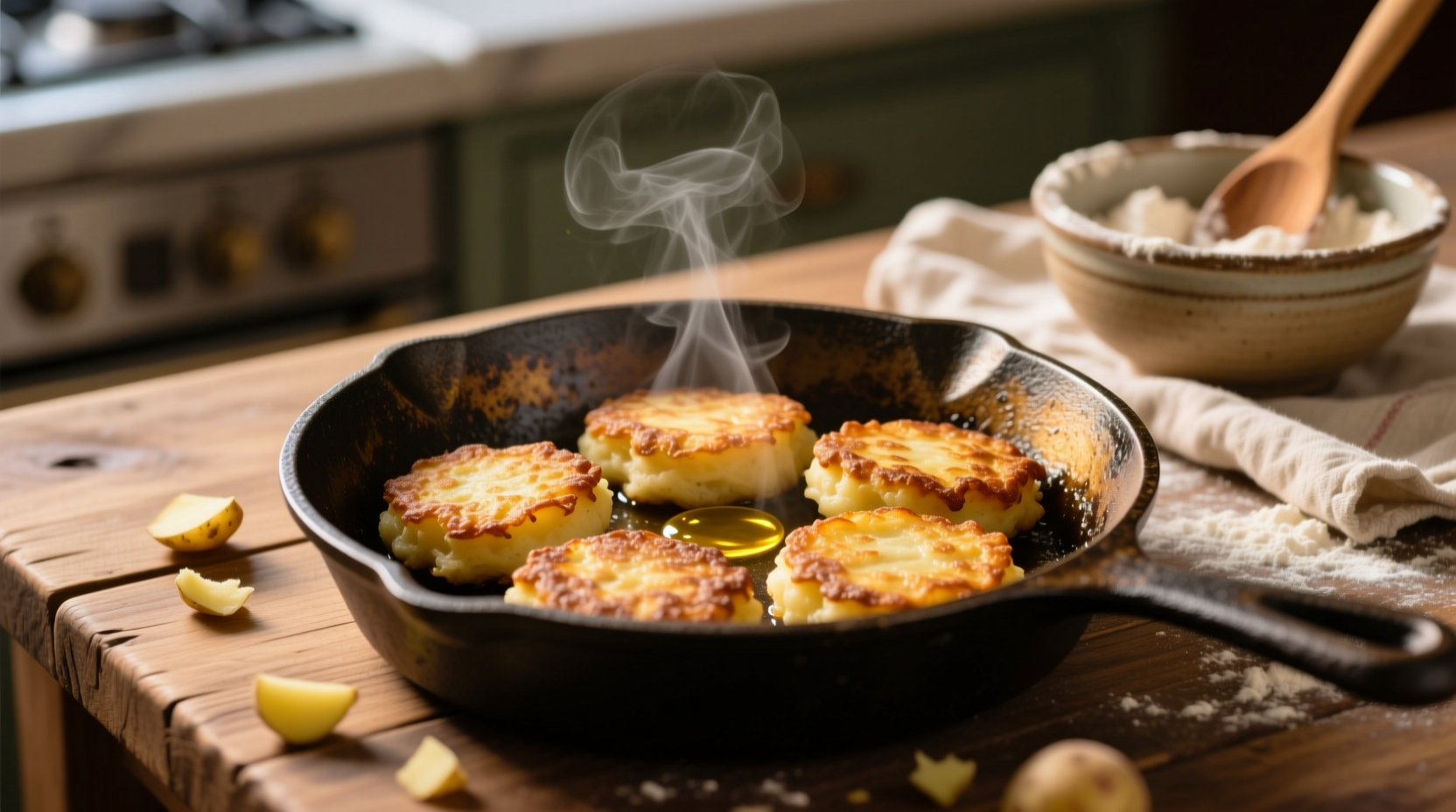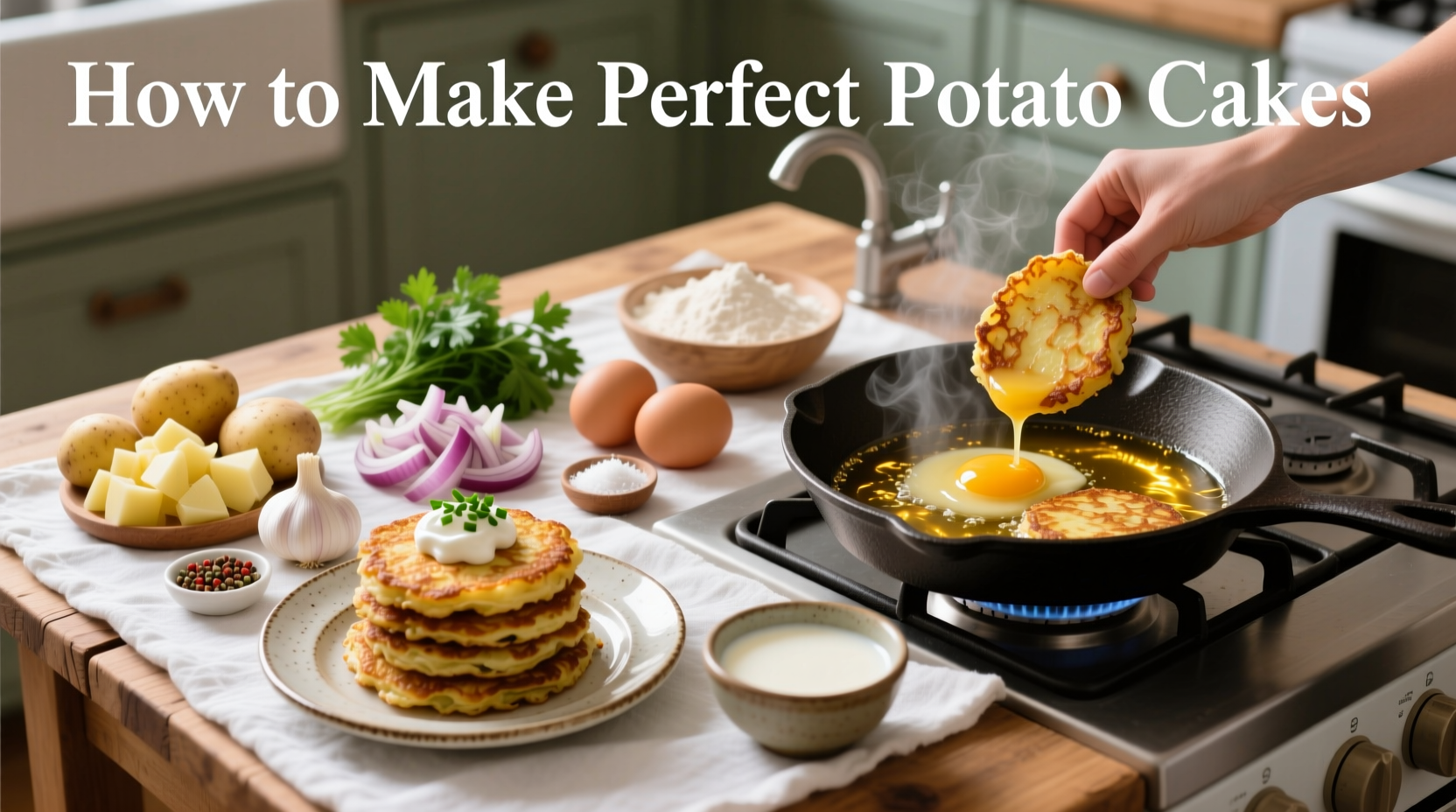Why This Potato Cakes Recipe Works
Creating exceptional potato cakes isn't just about following steps—it's understanding the food science behind each technique. When potatoes are grated, their starches oxidize and release moisture that can make cakes soggy. By properly managing this process, you transform simple ingredients into crispy, flavorful delights. Professional chefs consistently achieve better results by focusing on three critical factors: potato selection, moisture control, and precise temperature management.
| Common Potato Varieties | Starch Content | Best For Potato Cakes? | Why |
|---|---|---|---|
| Russet (Idaho) | High | Yes ✓ | Ideal starch content binds cakes while creating crisp exterior |
| Yukon Gold | Medium | Sometimes | Buttery flavor but higher moisture requires extra draining |
| Red Potatoes | Low | No ✗ | Waxy texture prevents proper binding and crisping |
| Sweet Potatoes | Medium | Variation | Different flavor profile; requires adjusted technique |
Essential Ingredients and Equipment
Using the right components makes a dramatic difference in your potato cakes' texture and flavor. Here's what you'll need:
Core Ingredients
- 2 lbs (900g) Russet potatoes (about 3 medium)
- 1 large yellow onion, finely grated
- 2 large eggs, beaten
- 3 tablespoons all-purpose flour (or matzo meal for Passover)
- 1½ teaspoons kosher salt
- ½ teaspoon freshly ground black pepper
- Vegetable oil for frying (enough to cover bottom of pan by ¼ inch)
Must-Have Equipment
- Box grater or food processor with grating attachment
- Clean kitchen towel or cheesecloth
- Heavy-bottomed skillet (cast iron preferred)
- Instant-read thermometer
- Spatula with thin edge
The Potato Cake Timeline: From Preparation to Perfect Results
Understanding the historical evolution of potato cakes helps appreciate why certain techniques matter. Potatoes arrived in Europe in the 16th century, but potato cakes as we know them developed in the 19th century when grating tools became widely available. The traditional method evolved to address a critical challenge: managing potato moisture.
- Preparation (15 minutes): Peel and grate potatoes using the large holes of a box grater. Immediately place in cold water to prevent browning.
- Moisture Management (10 minutes): Drain potatoes, then squeeze thoroughly using a kitchen towel—this critical step removes excess water that causes sogginess.
- Mixing (5 minutes): Combine potatoes, onions, eggs, flour, salt, and pepper. Avoid overmixing to prevent gummy texture.
- Cooking (12-15 minutes): Heat oil to 350°F (175°C), form patties, and fry 3-4 minutes per side until golden brown.
- Draining (2 minutes): Transfer to paper towel-lined plate to remove excess oil.

Avoiding Common Mistakes: Context Boundaries That Matter
Many home cooks encounter problems because they don't understand the specific conditions required for success. These context boundaries separate good potato cakes from great ones:
- Temperature Threshold: Oil below 325°F (163°C) causes cakes to absorb excess oil; above 375°F (190°C) leads to burnt exteriors with raw interiors. The USDA Food Safety and Inspection Service confirms that proper frying temperature prevents oil absorption while ensuring thorough cooking (source).
- Moisture Limit: Potatoes must contain less than 70% moisture content for optimal binding. Excess moisture creates steam during frying, preventing crispness.
- Patty Thickness Boundary: 1/2 inch (1.25 cm) is the ideal thickness. Thinner cakes burn easily; thicker ones won't cook through before the exterior darkens.
Step-by-Step Cooking Process
Preparation Phase: Setting Yourself Up for Success
Start with cold potatoes—refrigerate them for 1-2 hours before grating. Cold potatoes hold their structure better during grating. Use the large holes of your box grater for optimal texture; fine shreds create dense cakes while large chunks won't bind properly.
Moisture Management: The Critical Step Most People Skip
This is where 90% of failures occur. After grating:
- Squeeze handfuls of potatoes over the sink using a clean kitchen towel
- Apply firm, consistent pressure for 30 seconds per handful
- Check moisture by pressing a small amount—if water drips, continue squeezing
- Transfer dry potatoes to a large bowl
Food science research from the University of California Davis Department of Food Science and Technology confirms that proper moisture removal prevents gelatinization of starches during cooking, which is essential for achieving crisp texture (source).
Cooking Technique: Precision Temperature Control
Heat 1/4 inch of oil in your skillet over medium-high heat. Use an instant-read thermometer to verify temperature—this isn't optional for consistent results. Form patties by pressing 1/3 cup of mixture firmly between your palms, then gently flatten to 1/2 inch thickness.
Fry 3-4 cakes at a time (overcrowding drops oil temperature). Wait for the first signs of golden browning around the edges before flipping—this typically takes 3-4 minutes. The second side usually cooks faster (2-3 minutes). Drain on wire rack over paper towels to maintain crispness.
Proven Variations for Different Dietary Needs
- Gluten-Free: Substitute matzo meal or almond flour for all-purpose flour
- Lower Fat: Bake at 425°F (220°C) on parchment-lined sheet for 20-25 minutes, flipping halfway
- Irish Boxty: Add 2 tablespoons buttermilk and substitute half the potatoes with mashed potatoes
- Latke Variation: Include 1/4 teaspoon baking powder for extra lift and crispness
Troubleshooting Guide: Fixing Common Problems
| Problem | Most Likely Cause | Solution |
|---|---|---|
| Cakes fall apart | Insufficient binding or excess moisture | Squeeze potatoes more thoroughly; add 1 extra egg or 1 tbsp flour |
| Soggy texture | Oil temperature too low or overcrowded pan | Use thermometer; cook in smaller batches; increase oil temp to 360°F |
| Burnt exterior, raw interior | Oil temperature too high | Reduce heat; maintain 340-350°F; make thinner patties |
| Bland flavor | Underseasoned or old potatoes | Add salt between potato layers while squeezing; use fresh potatoes |
Serving and Storage Recommendations
Serve potato cakes immediately for peak crispness. Traditional accompaniments include applesauce and sour cream, but modern variations pair well with smoked salmon and dill crème fraîche. For storage, cool completely then refrigerate in an airtight container for up to 3 days. Reheat in a 400°F (200°C) oven for 8-10 minutes to restore crispness—microwaving creates sogginess.











 浙公网安备
33010002000092号
浙公网安备
33010002000092号 浙B2-20120091-4
浙B2-20120091-4